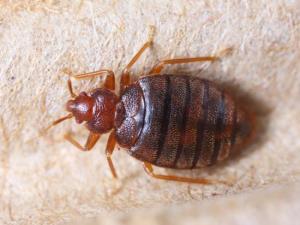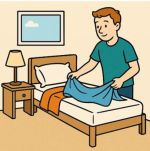Identifying bedbugs
Bed bugs are:
- wingless
- oval-shaped
- flattened insects
- usually about 6mm long.
When they have not eaten, they are pale brown in colour but become reddish brown to mahogany when fully fed on blood.
The head has large antennae and the mouthparts are well adapted for piercing the skin.
The feet have claws and the legs are well developed.
Young bugs (nymphs) are nearly colourless, becoming brownish as they mature and moult five times before adulthood.

Where are they found?
You can often find bedbugs:
- under carpets
- behind loose wallpaper
- behind wall pictures
- behind door frames
- around the arm joints of armchairs and settees
- in the seams of mattresses and bed frame
Bedbugs can crawl vertically up wood, paper and plaster, but not smooth polished surfaces.
Their droppings look like black dots, which can also be a tell-tale sign. Bites from fleas are usually restricted to below the knees, bites more evenly distributed on the human body are more frequently caused by bedbugs.
Home treatments for bedbugs
An adult must be present throughout each visit. Treatments in your home involve:
- two visits, three weeks apart
- treating bedrooms and other affected rooms
- an advice sheet with information about the insecticide we used, where we placed it and any special precautions needed
- taking measures to protect children and pets
How to prepare your home for bedbug treatment
Before the treatment you should:
- remove pictures, posters, mirrors and any other items from walls
- move all beds, furniture, and other items away from the walls
- remove headboards from beds
- empty any bed storage compartments or drawers
- remove all items from under the bed
- remove bedding from the mattress
- empty wardrobes, drawers, cupboards and beds of all linen and clothing and launder
- place any items which cannot be laundered in thick bin liners and seal tightly
- open and shake-out books, papers, CDs, DVDs and videos
- lift all carpets around the edge of the room and leave them loose
- thoroughly clean and vacuum all rooms and empty the vacuum bag into the external bin immediately
Do not move anything out of the rooms to be treated, apart from rubbish and clothing that will need to be washed.
Before the first and second visit, and following laundry label instructions, any clothes or bed linen must be either be:
- hot washed at a minimum of 60 degrees celsius
- tumble dried at a minimum of 60 degrees celsius for at least 30 minutes
- placed in a deep freezer for at least 3 days
- dry-cleaned
Other things to do before the treatment starts:
- unplug all non-essential electrical items
- leave rooms to be treated and take all pets with you
After the treatment, you should:
- wait three hours before re-entering the rooms
- open the windows for an hour
- turn on electrical items after the rooms have been aired
- do not vacuum, wipe or polish any treated rooms for at least 2 weeks
- sleep in your bed as normal - it helps to eradicate the bedbugs
If you wish to get a new bed, do not do so until the infestation is completely eradicated (which normally takes a minimum of 2 weeks and sometimes longer).
Easy read bed bug treatment guide

How much does it cost?
£300.00 ( 2 visits to the property covering 2 bedrooms).
£26 per additional room.
£150.00 per additional visit.
For commercial rates and information see Landlords, commercial premises, restaurants and schools.
Make a booking
Contact us
For queries about bookings and payments or to make a follow up booking fill in our contact form or call us on 020 8753 1081.